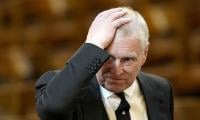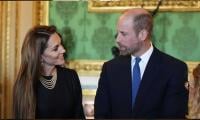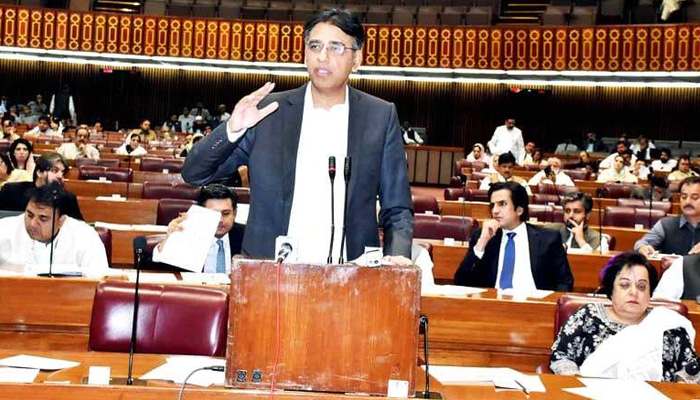‘Status quo’ further strengthened
Finance Minister Asad Umar, in his first supplementary budget, reversed some of the rare progressive measures taken in the last PML-N budget, such as by allowing non-filers to buy cars and properties banned by previous government, while further strengthening the reactionary fiscal and financial stabilization adjustments in preparation for becoming an eligible beggar from both bilateral and multilateral donors, including probably the IMF.
Finance Minister Asad Umar, in his first supplementary budget, reversed some of the rare progressive measures taken in the last PML-N budget, such as by allowing non-filers to buy cars and properties banned by previous government, while further strengthening the reactionary fiscal and financial stabilization adjustments in preparation for becoming an eligible beggar from both bilateral and multilateral donors, including probably the IMF.
The fiscal and financial deficits are the estranged symptoms of a dependent and unsustainable economy condemned to meet the overwhelming demands of a rent-seeking elite and over-burdening parasitic superstructures or a client state. As always fiscal cuts have been applied to the Public Sector Development Program (PSDP) by Rs 305 billion—not on unsustainable current expenditures, including the ministries and divisions rendered superfluous by the 18th amendment and ever-increasing defense expenditures.
The burden of taxation has been further added on the back of already taxed and the masses to the tune of Rs 183 billion—not including Rs 375 billion to be paid by consumers on account of increased prices of gas and petroleum. Overall impact of all the adjustments is to the tune of 2.1 percent of the GDP or Rs 814 billion. With these measures the finance minister expects to bring down fiscal deficit from 6.6 per cent of GDP to 5.1 percent of GDP (Rs 1.9 trillion), instead of what he in his revised estimates projected to be 7.2 percent of GDP.
These measures are going to increase inflation up to 8-10 percent, decrease growth, at least by one per cent of the GDP, from 5.8 percent to less than five percent resulting in higher unemployment. The trade and current account deficits would still remain high in the absence of drastic measures to expand tax net and drastically cut current expenditures, curb luxurious consumptions and expand export base both quantitatively and qualitatively.
Despite two IMF adjustment programs, both the PPP and the PML-N governments failed to bring down fiscal deficit; it remained where it was in 2013 i.e., 6.6 percent plus 1.86 other deficits or 8.2 percent of GDP. The trade deficit, which had increased from $32.5 billion to $37.6 billion in 2017-18 despite the fall in 700 import lines, small tinkering in trade regime won’t help bring down the current account deficit from the peak of $18 billion (5.7 percent of GDP) last year. Consequently, in the absence of some revolutionary measures, the debt would continue to rise as it rose from $60 billion in 2013 to $95 billion in 2018. These facts should have given some food for thought to the Imran Khan government that without fundamental systemic and structural changes, Pakistan cannot get out of its twin-deficits and the debt-trap.
If Asad Umar’s approach is taken into account, as exhibited by his supplementary fiscal measures, the PTI government will end up in adding greater fiscal and financial deficits and a much higher debt burden. The supplementary budget indicates that Mr Umar is probably preparing to beg another bailout package from the IMF, besides filling the empty coffers with more bilateral loans from Saudi Arabia, China and other sources.
Prime Minister’s visit to Saudi Arabia, COAS General Bajwa’s damage controlling visit to China to ensure the continuity of CPEC and US Secretary of State Pompeo’s assurance not to hinder any IMF deal followed by Naval Chief’s trip to the US to remain a partner in maintaining maritime stability show the desperateness of the new power-block to ensure conflicting client-patron relationships. The results, however, won’t be dissimilar to the Imran Khan government’s predecessors because it is treading the same beaten track of structural adjustments for macroeconomic stabilization in the fiscal sphere alone. Even the GDP growth that we witnessed in previous years would go down due to increased demand management.
Much publicized but superficial austerity measures along with some minor adjustments in expenditure won’t save more than some peanuts (some estimates indicate Rs 3 billion saving only) as compared to a huge budgetary deficit. Blind hopes from the heavenly windfall gains from the miraculous return of looted billions will take time to dash to the ground. Similarly, a vengeful, politically motivated and selective accountability of the leaders and officials of the two previous governments, former prime minister Nawaz Sharif in particular, is not likely to bring back the plundered national wealth, which is mindlessly being projected to be in the vicinity of the cost equal to four Bhasha dams.
Again we are being sold the mantra of a huge dam for which we do not have enough resources and the people are being asked to contribute their last pennies in the belief that it will solve all issues related to climate change and the looming water crises, despite ecological damages and human displacement, and scarcity of water notwithstanding. Had the Chief Justice asked his brother judges, civil and military officials to have their salaries and perks, the two dams could have been built so easily and without a recourse to foreign debt.
Despite social-liberal intelligentsia’s skepticism of the “regime of change”, Imran Khan’s continuous rhetoric to address poverty, illiteracy, mal-nutrition, endemic diseases, lack of clean drinking water, homelessness, de-forestation and under-development of neglected regions did make some sense. However, there is not even a one-liner in the empty mini-budget speech of the fiancé minister to cover any of the much touted social issues. Nor is there any indicator from over dozens of “task forces”, filled with the same old bureaucrats, that could sustain the momentum of an otherwise false “change”.
The notions about the “change from above” with a messiah as supreme helmsman should have come to grief with the induction of evil gentry at the top of the Pakistan Tehreek-i-Insaf (PTI) before the elections and selection of the federal and two provincial cabinets consisting mostly of the same lot that the PTI had stood against for over two decades.
The real question that have to be asked is not about stupid economy and the solutions being sought by the proponents and beneficiaries of neo-liberal economics that the prime minister so profusely continues to reject. These are the questions of political economy that need to be addressed before any exercise at reforms, i.e., character of the regime underpinned by the dominant social and neo-colonial structures of the same rotten status quo. Given the nature of civil-military power structure, propped up by a questionable electoral exercise, no big social change can be expected, except some symbolic and tertiary measures to keep a hapless mass of people in an illusion of change, however, cosmetic it may be.
The character of the current civil-military regime will be simply judged on the criteria of who does it tax and where and on whom does it spend. If compared with the two previous regimes, there is not an iota of difference you can find in the new balance sheet that our new fiancé minister even shied to present before the Parliament. A dependent and under-developed economy with a superimposed heavy client state has to live on the borrowed time while living and striving beyond its means. Until this neo-colonial shackle is broken, the people are condemned to live in hell, despite their doubled and tripled labor. Without a government of the poor by the poor and for the poor, the gulf between the rich and starved Pakistan(s) will continue to widen.
-
 Chad Michael Murray Admits 2000s Fame Could Have 'destroyed' Him
Chad Michael Murray Admits 2000s Fame Could Have 'destroyed' Him -
 Emma Stone Reflects On Diane Keaton's 'most Valuable' Lesson
Emma Stone Reflects On Diane Keaton's 'most Valuable' Lesson -
 Kanye West Once Paid $1 Million Per Day To Record Album: Here's Why
Kanye West Once Paid $1 Million Per Day To Record Album: Here's Why -
 Prince Harry Hopes To Show Archie, Lilibet Where He 'grew Up'
Prince Harry Hopes To Show Archie, Lilibet Where He 'grew Up' -
 Jacob Elordi Names Childhood Crushes Including A Major 60s Star
Jacob Elordi Names Childhood Crushes Including A Major 60s Star -
 Kristin Davis Dicusses Fate Of Her Sex And The City Character
Kristin Davis Dicusses Fate Of Her Sex And The City Character -
 Zara Larsson Steps Up Criticism Against 'evil' Policies
Zara Larsson Steps Up Criticism Against 'evil' Policies -
 Adam Sandler Jokes About Aging As He Accepts Career Honour
Adam Sandler Jokes About Aging As He Accepts Career Honour -
 Royal Stalker Cases Increase Following Harry, Meghan's Marriage: Report
Royal Stalker Cases Increase Following Harry, Meghan's Marriage: Report -
 Sarah Ferguson Eyes Princess Diana’s Private Letters In Bid To Secure Future
Sarah Ferguson Eyes Princess Diana’s Private Letters In Bid To Secure Future -
 Andrew Plots Secret Sales Of Royal Jewels Amid Royal Lodge Eviction
Andrew Plots Secret Sales Of Royal Jewels Amid Royal Lodge Eviction -
 Abbott Elementary Star Chris Perfetti Hints At What To Expect From Season 5
Abbott Elementary Star Chris Perfetti Hints At What To Expect From Season 5 -
 Prince William Always Ready To Step Up: ‘He’s Barely Able To Contain His Fury When Kate’s Involved’
Prince William Always Ready To Step Up: ‘He’s Barely Able To Contain His Fury When Kate’s Involved’ -
 Florida Woman ‘tricked Innocent Movers Into Helping Her’ $7k Burglary: Report
Florida Woman ‘tricked Innocent Movers Into Helping Her’ $7k Burglary: Report -
 Harry Deserves Top Protection As King Charles’ Son, Prince William’s Brother
Harry Deserves Top Protection As King Charles’ Son, Prince William’s Brother -
 Meghan Markle Receives Key Advice As Experts Warn She’s Doing Too Much
Meghan Markle Receives Key Advice As Experts Warn She’s Doing Too Much




